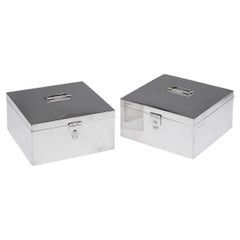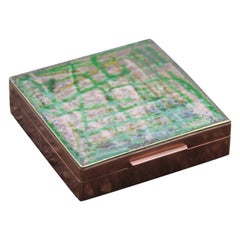Portable Cigar Box
20th Century British Art Deco Cigar Boxes and Humidors
Silver
Vintage 1950s Italian Mid-Century Modern Cigar Boxes and Humidors
Copper, Enamel
People Also Browsed
Vintage 1970s Italian Modern Chandeliers and Pendants
Murano Glass, Blown Glass, Art Glass, Glass
21st Century and Contemporary Portuguese Animal Sculptures
Porcelain
1990s Italian Mid-Century Modern Chairs
Steel
21st Century and Contemporary Italian Modern Pitchers
Glass
20th Century Russian Decorative Boxes
Gold
20th Century American Mid-Century Modern Desk Sets
Enamel
Vintage 1950s Italian Dressers
Iron
Early 20th Century Austrian Arts and Crafts Chandeliers and Pendants
Metal, Brass, Wire
Vintage 1970s Italian Mid-Century Modern Wall Lights and Sconces
Brass
20th Century British Victorian Animal Sculptures
Ceramic
21st Century and Contemporary Italian Animal Sculptures
Crystal, Gold Plate, Brass
Vintage 1950s French Mid-Century Modern Console Tables
Metal
Vintage 1960s Italian Mid-Century Modern Table Lamps
Metal
Vintage 1960s American Mid-Century Modern Coffee and Cocktail Tables
Ceramic, Walnut
Mid-20th Century Brazilian Beds and Bed Frames
Rosewood, Cane
Antique 15th Century and Earlier Chinese Tang Antiquities
Pottery
A Close Look at Mid-century-modern Furniture
Organically shaped, clean-lined and elegantly simple are three terms that well describe vintage mid-century modern furniture. The style, which emerged primarily in the years following World War II, is characterized by pieces that were conceived and made in an energetic, optimistic spirit by creators who believed that good design was an essential part of good living.
ORIGINS OF MID-CENTURY MODERN FURNITURE DESIGN
- Emerged during the mid-20th century
- Informed by European modernism, Bauhaus, International style, Scandinavian modernism and Frank Lloyd Wright’s architecture
- A heyday of innovation in postwar America
- Experimentation with new ideas, new materials and new forms flourished in Scandinavia, Italy, the former Czechoslovakia and elsewhere in Europe
CHARACTERISTICS OF MID-CENTURY MODERN FURNITURE DESIGN
- Simplicity, organic forms, clean lines
- A blend of neutral and bold Pop art colors
- Use of natural and man-made materials — alluring woods such as teak, rosewood and oak; steel, fiberglass and molded plywood
- Light-filled spaces with colorful upholstery
- Glass walls and an emphasis on the outdoors
- Promotion of functionality
MID-CENTURY MODERN FURNITURE DESIGNERS TO KNOW
- Charles and Ray Eames
- Eero Saarinen
- Milo Baughman
- Florence Knoll
- Harry Bertoia
- Isamu Noguchi
- George Nelson
- Danish modernists Hans Wegner and Arne Jacobsen, whose emphasis on natural materials and craftsmanship influenced American designers and vice versa
ICONIC MID-CENTURY MODERN FURNITURE DESIGNS
- Eames lounge chair
- Nelson daybed
- Florence Knoll sofa
- Egg chair
- Womb chair
- Noguchi coffee table
- Barcelona chair
VINTAGE MID-CENTURY MODERN FURNITURE ON 1STDIBS
The mid-century modern era saw leagues of postwar American architects and designers animated by new ideas and new technology. The lean, functionalist International-style architecture of Le Corbusier and Bauhaus eminences Ludwig Mies van der Rohe and Walter Gropius had been promoted in the United States during the 1930s by Philip Johnson and others. New building techniques, such as “post-and-beam” construction, allowed the International-style schemes to be realized on a small scale in open-plan houses with long walls of glass.
Materials developed for wartime use became available for domestic goods and were incorporated into mid-century modern furniture designs. Charles and Ray Eames and Eero Saarinen, who had experimented extensively with molded plywood, eagerly embraced fiberglass for pieces such as the La Chaise and the Womb chair, respectively.
Architect, writer and designer George Nelson created with his team shades for the Bubble lamp using a new translucent polymer skin and, as design director at Herman Miller, recruited the Eameses, Alexander Girard and others for projects at the legendary Michigan furniture manufacturer.
Harry Bertoia and Isamu Noguchi devised chairs and tables built of wire mesh and wire struts. Materials were repurposed too: The Danish-born designer Jens Risom created a line of chairs using surplus parachute straps for webbed seats and backrests.
The Risom lounge chair was among the first pieces of furniture commissioned and produced by celebrated manufacturer Knoll, a chief influencer in the rise of modern design in the United States, thanks to the work of Florence Knoll, the pioneering architect and designer who made the firm a leader in its field. The seating that Knoll created for office spaces — as well as pieces designed by Florence initially for commercial clients — soon became desirable for the home.
As the demand for casual, uncluttered furnishings grew, more mid-century furniture designers caught the spirit.
Classically oriented creators such as Edward Wormley, house designer for Dunbar Inc., offered such pieces as the sinuous Listen to Me chaise; the British expatriate T.H. Robsjohn-Gibbings switched gears, creating items such as the tiered, biomorphic Mesa table. There were Young Turks such as Paul McCobb, who designed holistic groups of sleek, blond wood furniture, and Milo Baughman, who espoused a West Coast aesthetic in minimalist teak dining tables and lushly upholstered chairs and sofas with angular steel frames.
Generations turn over, and mid-century modern remains arguably the most popular style going. As the collection of vintage mid-century modern chairs, dressers, coffee tables and other furniture for the living room, dining room, bedroom and elsewhere on 1stDibs demonstrates, this period saw one of the most delightful and dramatic flowerings of creativity in design history.
Materials: Copper Furniture
From cupolas to cookware and fine art to filaments, copper metal has been used in so many ways since prehistoric times. Today, antique, new and vintage copper coffee tables, mirrors, lamps and other furniture and decor can bring a warm metallic flourish to interiors of any kind.
In years spanning 8,700 BC (the time of the first-known copper pendant) until roughly 3,700 BC, it may have been the only metal people knew how to manipulate.
Valuable deposits of copper were first extracted on the Mediterranean island of Cyprus around 4,000 BC — well before Europe’s actual Bronze Age (copper + tin = bronze). Tiny Cyprus is even credited with supplying all of Egypt and the Near East with copper for the production of sophisticated currency, weaponry, jewelry and decorative items.
In the 15th, 16th and 17th centuries, master painters such as Leonardo da Vinci, El Greco, Rembrandt and Jan Brueghel created fine works on copper. (Back then, copper-based pigments, too, were all the rage.) By the late 19th and early 20th centuries, decorative items like bas-relief plaques, trays and jewelry produced during the Art Deco, Arts and Crafts and Art Nouveau periods espoused copper. These became highly valuable and collectible pieces and remain so today.
Copper’s beauty, malleability, conductivity and versatility make it perhaps the most coveted nonprecious metal in existence. In interiors, polished copper begets an understated luxuriousness, and its reflectivity casts bright, golden and earthy warmth seldom realized in brass or bronze. (Just ask Tom Dixon.)
Outdoors, its most celebrated attribute — the verdigris patina it slowly develops from exposure to oxygen and other elements — isn’t the only hue it takes. Architects often refer to shades of copper as russet, ebony, plum and even chocolate brown. And Frank Lloyd Wright, Renzo Piano and Michael Graves have each used copper in their building projects.
Find antique, new and vintage copper furniture and decorative objects on 1stDibs.
Finding the Right Cigar-boxes for You
Cigars were not always packaged in what we now know as the antique cigar boxes and humidors that have over time become eye-catching decorative objects as well as collector’s items.
Outside the United States, cigar boxes are said to have originated in the 1840s when a German businessman, Hermann Dietrich Upmann of H. Upmann Cigars, bought a cigar factory and opened a bank in Havana, Cuba. Upmann reportedly handed out cedar cigar boxes branded with advertising for the bank as gifts to his banking clients. In the early 1860s, after years of cigars being shipped in big crates or barrels, cigar boxes became a requirement when the United States passed a law that mandated the use of boxes for tobacco producers, which was part of a broader effort to regulate the tobacco industry and generate revenue for the war effort. Humidors, which are moisture-controlled storage boxes that allow a cigar enthusiast to store, organize and preserve a larger collection of cigars, were very popular accessories during the early 1900s onward.
As the use of cigar boxes and humidors became widespread, all kinds of options materialized over the years, with particularly vibrant editions of these decorative objects emerging during the Art Nouveau, mid-century modern and other eras. Visionary designers like Isamu Noguchi popularized the idea of tobacco accessories as art with projects such as his decorative ashtrays.
Today, not unlike antique and vintage ashtrays, cigar boxes are more than practical objects. In fact, there are many uses for an old cigar box even after the cigars are gone. They can be used as planters, tissue boxes or can support your long-delayed effort to organize your sewing and craft supplies. During the Great Depression, an emptied cigar box — perhaps a walnut Art Deco-style cigar box with inlays in bronze and hand-carved decorative geometric patterns adorning its exterior — was occasionally repurposed as a jewelry box.
Antique and vintage cigar boxes — made of wood, metal or other materials — are valuable treasures in some corners of the collecting world, and in your home, they’re exquisite desk ornaments and colorful flourishes to add to your bookcase or mantel. On 1stDibs, find a variety of antique and vintage cigar boxes and other decorative boxes today.
- 1stDibs ExpertApril 5, 2022How long you can keep cigars in a box depends on whether the box is open. Sealed boxes may keep cigars fresh for a few months. After you open the box, you should smoke the cigars within one month or place them in a humidor to keep them fresh. You'll find a selection of cigar boxes on 1stDibs.
- 1stDibs ExpertMarch 22, 2022Yes, although whether or not a cigar box can be used as a humidor depends on its design. Only cigar boxes that seal well and are crafted entirely out of wood and lined with cedar should be used as humidors. You will also need to add a humidification device to the box to preserve the freshness of your cigars. On 1stDibs, find a collection of humidors.
- 1stDibs ExpertApril 5, 2022To tell how old a cigar box is, look for the caution notice. Caution notices are required by law but before 1910, they were pasted on the cigar box. After 1910, caution notices were printed directly onto the bottom of the box. Shop a collection of antique cigar boxes from some of the world’s top sellers on 1stDibs.
- 1stDibs ExpertApril 5, 2022Cigar boxes can be made of cardboard, paper and several kinds of wood. Spanish cedar is a popular choice for cigar boxes but mahogany, white oak and elm are also common. On 1stDibs, you’ll find a collection of antique cigar boxes from some of the world’s top sellers.
Read More
How Noguchi Elevated Ashtrays to Objets d’Art
Smoking might have fallen out of fashion, but these ashtrays have enduring design appeal.
Jeff Andrews Captures Old Hollywood Glamour in His Cinematic Spaces
Having created extravagant homes for reality TV’s biggest stars, the designer is stepping into the spotlight with his first book.
Tapio Wirkkala Bucked the Trends of Mid-Century Nordic Design
The Finnish talent created nature-inspired pieces, from furniture to jewelry, with phenomenal staying power.

